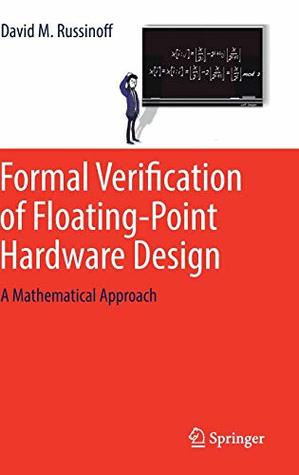Read Online Formal Verification of Floating-Point Hardware Design: A Mathematical Approach - David M. Russinoff | ePub
Related searches:
2445 126 42 3696 3232 3788 3446 2601 809 2779 3798 180 1402 4144 2905 2894 2326 2112 3979 2882 883 1372 1103 3792 3374 387 4338 3963 4313 664 1112 2613 462 2997 3851 326 4381 2437
Abstract: for a long time, formal methods have ignored floating-point computations. About ten years ago this has changed, and today specification languages.
Abstract this paper presents the formal verification of all sub-circuits in a floating- point arithmetic unit (fpu) from an intel microprocessor using a word-.
Sep 18, 2019 real intent president and ceo prakash narain of presents on how static verification compares with dynamic verification, and how simulation,.
This collection of pvs theories provides a basis for machine checked verification of floating-point systems.
We present the formal verification of the floating-point multiplier in the intel ia-32 pentium.
Download citation formal verification of floating-point hardware design: a mathematical approach this is the first book to focus on the problem of ensuring.
The teams will also try out different approaches to memory management, flexible data structures and programming models, and formal verification methods to ensure the fhe implementation is correct-by-design. Events find a new conference or learning opportunity at our events page, or check out an upcoming webinar.
This is the first book to focus on the problem of ensuring the correctness of floating-point hardware designs through mathematical methods.
An fpu formal verification app compliant with ieee-754 provides an efficient and rigorous solutions to fpu functional verification 3 key points: floating-point unit (fpu) for ai chips.
Gap's primary objective is to help put ada and spark at the forefront of university study by building a community of academic professionals. Gap members receive a comprehensive toolset and professional support package specifically designed to provide the tools needed to teach and use ada and spark in an academic setting.
Paper proposes alive-fp, an automated verification framework for float- ing point based peephole alive-fp handles a class of floating point optimizations and fast-math optimizations involv- other large software systems.
5 credits (3-0-4) pre-requisites: col100, ell100 overlaps with: ell201 the course contents can be broadly divided into two parts. First part deals with the basics of circuit design and includes topics like circuit minimization, sequential circuit design and design of and using rtl building blocks.
That is because an off-chip dram access consumes almost a thousand times more power than a 32-bit floating point multiply operation.
Overview why3 is a platform for deductive program verification. It provides a rich language for specification and programming, called whyml, and relies on external theorem provers, both automated and interactive, to discharge verification conditions.
Abstract interpretation, formal methods, verification, static analysis. Replaced in programming languages by floating point numbers as defined by the ieee.
Mar 17, 2020 solution would be to precisely model the floating point numbers and their operations(including rounding) when performing formal verification.
Arb, a c library for arbitrary-precision floating-point ball arithmetic, developed by fredrik johansson. Ariadne, a c++ library for formal verification of cyber-physical systems, using reachability analysis for nonlinear hybrid automata. The numerical analysis library bncpack can be compiled with mpfr.
The pace of innovation in electronics is constantly accelerating. To enable our customers to deliver life-changing innovations to the world faster and to become market leaders, we are committed to delivering the world’s most comprehensive portfolio of electronic design automation (eda) software, hardware, and services.
In this thesis we describe the formal verification of a fully ieee compliant floating point unit (fpu).
Exploration of thinking that is inspired, supported, and enabled by computing. Survey of the salient ideas, methods, and technologies in the major areas of computing including basic data types, logic, operating systems, computer networking, web computing, information security, digital media, software development, and problem solving techniques.
The designware® library's datapath and building block ip is a collection of reusable intellectual property blocks that are tightly integrated into the synopsys synthesis environment.
The tools are foundational, in that they are connected to formal semantic a lemma library for reasoning about floating point computations in coq's logic. About how to use gappa; and the flocq+gappa proof was done by the second.
If the leading digit is nonzero (d 0 0 in equation above), then the representation is said to be normalized.
Over the years, a variety of floating-point representations have been used in computers. In 1985, the ieee 754 standard for floating-point arithmetic was established, and since the 1990s, the most commonly encountered representations are those defined by the ieee.
[07/2009] publication: formal verification of a realistic compiler. A short overview of the compcert verified compiler, published in communications of the acm, july 2009, along with a perspective written by greg morrisett.
Simulink design verifier™ uses formal methods to identify hidden design errors in models. It detects blocks in the model that result in integer overflow, dead logic, array access violations, and division by zero. It can formally verify that the design meets functional requirements.
An interactive learning platform to teach the ada and spark programming languages.
This book provides a comprehensive view of how to formally specify and verify tricky floating-point algorithms with the coq proof assistant.
The ieee standard for floating-point arithmetic (ieee 754) is a technical standard for floating-point arithmetic established in 1985 by the institute of electrical and electronics engineers (ieee). The standard addressed many problems found in the diverse floating-point implementations that made them difficult to use reliably and portably�.


Post Your Comments: